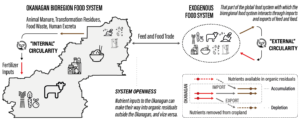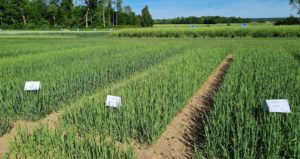Category: English
New Formas project in the call From research to implementation for a sustainable society 2021
Cecilia Lalander from the Department of Energy and Technology and Anders Kiessling from the Department of Animal Nutrition and Management are part of a project with partners from all over Sweden who have just been granted SEK 3.8 million from FORMAS for a pilot project in which artificial intelligence (AI) will support the development of a sustainable urban food production system.
 Northern Sweden has recently attracted large industries and server halls as well as the next generation fossil-free steel industry (H2GreenSteel), due to its easy access to renewable energy and natural resources, as well as a cool climate. Boden municipality aims to be Europe’s most resource-efficient and carbon-neutral municipality by 2025. In fact, since 2020, Boden has initiated a large-scale symbiosis project called the Boden Energy Symbiosis, part of the Boden Business Park. In fact, since 2020 Boden has initiated a large-scale symbiosis project called the Boden Symbiosis Cluster, part of the Boden Business Park. One of the initiatives aim at creating an urban food competence platform of commercial size to be used as a national asset for implementing and testing innovative solutions for food production systems.
Northern Sweden has recently attracted large industries and server halls as well as the next generation fossil-free steel industry (H2GreenSteel), due to its easy access to renewable energy and natural resources, as well as a cool climate. Boden municipality aims to be Europe’s most resource-efficient and carbon-neutral municipality by 2025. In fact, since 2020, Boden has initiated a large-scale symbiosis project called the Boden Energy Symbiosis, part of the Boden Business Park. In fact, since 2020 Boden has initiated a large-scale symbiosis project called the Boden Symbiosis Cluster, part of the Boden Business Park. One of the initiatives aim at creating an urban food competence platform of commercial size to be used as a national asset for implementing and testing innovative solutions for food production systems.
Our latest publication on black soldier fly larvae composting
 Check out our latest publication in Waste Management Process efficiency in relation to enzyme pre-treatment duration in black soldier fly larvae composting. We investigated the impact of enzyme pre-treatment time duration on the efficiency, in terms of biomass conversion efficiency and material reduction, in black soldier fly larvae (BSFL) composting of lettuce and cabbage (vegetable cuttings from Grönsakshallen Sorunda). We found that direct addition of enzyme (i.e. no pre-treatment time, but adding the enzymes as the same time as the larvae) was the only treatment that significantly improved process efficiency.
Check out our latest publication in Waste Management Process efficiency in relation to enzyme pre-treatment duration in black soldier fly larvae composting. We investigated the impact of enzyme pre-treatment time duration on the efficiency, in terms of biomass conversion efficiency and material reduction, in black soldier fly larvae (BSFL) composting of lettuce and cabbage (vegetable cuttings from Grönsakshallen Sorunda). We found that direct addition of enzyme (i.e. no pre-treatment time, but adding the enzymes as the same time as the larvae) was the only treatment that significantly improved process efficiency.
Jennifer McConville awarded SLU’s Career Grant
Docent Jennifer McConville, at the Department of Energy and Technology, is one of the five researchers who has been awarded 3 million SEK as a career grant from the Vice-Chancellor of SLU.

SLU’s Career Grant is launched every second year to award researchers at the early stage of their careers. They receive a grant of 3 million SEK each. Jennifer McConville’s research uses systematic and applied sustainability analysis as decision support in planning and decision-making regarding sanitation and wastewater management. The aim is to improve resource recovery from these systems by adapting technical infrastructure and institutional arrangements. She performs her research in Sweden as well as low- and middle-income countries. She uses life cycle thinking, participation and socio-technical analysis to better understand and shape planning processes so that they can transition towards sustainability.
Jennifer McConville plans to use the career grant together with her research group to:
- Develop and apply new transdisciplinary methods for sustainability analysis with a focus on resource recovery
- Increase knowledge of trade-offs between different sustainability aspects
- Develop guidance for transitioning to sanitation systems with increased resource efficiency and equitable access for all
The results of Jennifer McConville’s research will help authorities responsible for sanitation and wastewater management to increase resource recovery and choose more sustainable systems.
Don’t flush the secret to sustainable agriculture down the toilet!

Prithvi, Jenna and Björn from the urine drying research group were interviewed for SLU’s Urban Futures. We discussed how redirecting our urine from our wastewater to our agricultural fields can help to reduced greenhouse gas emissions and to have more sustainable agriculture. Read the article here.
New publication on Co-composting of banana peel and orange peel waste with fish waste to improve conversion by black soldier fly (Hermetia illucens (L.), Diptera: Stratiomyidae) larvae
This study aimed to enhance the biodegradable solid waste management of low-quality food and agro-industrial waste streams, in terms of BSFL process performance efficiencies by means of co-composting. A fibre-rich, hard to degrade waste stream such as fruit peels by BSFL, was co-composted with a low-quality protein-rich waste stream (fish waste). Results show that co-composting has the ability to increase the BSFL composting efficiencies from nutrient-imbalanced substrates such those used in this study. Protein content increased as more fish waste was added into the substrate mixtures. Biomass conversion rate was generally increased by the addition of fish waste in the substrate mixtures and the highest conversion and BSFL weight achieved was 25 % and 269 mg larva-1, respectively, with 75 % fish waste (12 % protein addition) inclusion. However, BSFL treatment efficiency parameters showed wide variation with inclusion of 75 % fish waste in the substrate, possibly owing to differences in nutritional composition (especially fat content) of different fish waste batches. Lower variations in process efficiency renders higher reliability of the treatment process. Therefore, 25 % inclusion of fish waste (4 % protein addition) was concluded to be beneficial and sufficient enough to improve the overall BSFL process efficiency.
To read more, press here.
Isibika A., Vinnerås B., Kibazohi O., Zurbrügg C. & Lalander C. (2021) Co-composting of banana peel and orange peel waste with fish waste to improve conversion by black soldier fly (Hermetia illucens (L.), Diptera: Stratiomyidae) larvae. Journal of Cleaner Production 318, 128570
Assessing the Circularity of Nutrient Flows in the Okanagan Bioregion, BC Canada
The concept of “circular biobased economy” has become an important pillar of a new generation of policies that are expected to solve the current sustainability crisis. Moving towards a circular biobased economy crucially depends on biological and technical processes capable of recirculating plant nutrients – from used biobased products back to the production of food, feed, fibre, fuel, and so forth.
Nutrient flow analyses can help identify drivers of unsustainable patterns and opportunities for moving towards more sustainable patterns. As part of a broader food system design project in the Okanagan Bioregion, BC Canada, we analysed the flows of nitrogen, phosphorus, potassium, and magnesium to help stakeholders in the bioregion better understand current levels of nutrient circularity and how it could be improved.

Save! Toilet – How does the urine-diversion work?
In remembrance of Chris Buckley, a dear colleague and friend
 Chris Buckley was a dear colleague, mentor and friend. He passed away peacefully on the 27th May 2021 after a hard and brave fight against cancer. He is sorely missed. I remember the first day I met Chris very well – it was at World Water Week in Stockholm 2013. He’d never heard of me when I introduced myself as a young researcher from the Björn Vinnerås Lab at SLU, but that didn’t matter. Chris directly brought me into his professional social network and started connecting me with all who he thought I needed to meet. Over the years Chris continued to act as a catalyst in creating connections and opportunities for me. While at the same time influencing my work on urine-drying. I am so thankful for having him in my life and for all the wisdom he so graciously shared. Chris was a wonderful role model of how to be welcoming and hardworking while also knowing when to take break. For me, his legacy will live on through the projects that I am participating in thanks to him. Cheers Chris – missing you.
Chris Buckley was a dear colleague, mentor and friend. He passed away peacefully on the 27th May 2021 after a hard and brave fight against cancer. He is sorely missed. I remember the first day I met Chris very well – it was at World Water Week in Stockholm 2013. He’d never heard of me when I introduced myself as a young researcher from the Björn Vinnerås Lab at SLU, but that didn’t matter. Chris directly brought me into his professional social network and started connecting me with all who he thought I needed to meet. Over the years Chris continued to act as a catalyst in creating connections and opportunities for me. While at the same time influencing my work on urine-drying. I am so thankful for having him in my life and for all the wisdom he so graciously shared. Chris was a wonderful role model of how to be welcoming and hardworking while also knowing when to take break. For me, his legacy will live on through the projects that I am participating in thanks to him. Cheers Chris – missing you.
Written by Jenna Senecal
Update from the field trials on Gotland!
Day 49 in our Barley Field Trials – No visible difference between the urine fertilizer (right) and the mineral fertilizer (+control; left). While the barley that did not receive fertilizer (-control, middle) is shorter and a paler green.

